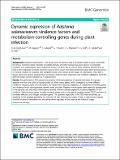Por favor, use este identificador para citar o enlazar a este item:
http://hdl.handle.net/10261/253797COMPARTIR / EXPORTAR:
 SHARE SHARE
 CORE
BASE CORE
BASE
|
|
| Visualizar otros formatos: MARC | Dublin Core | RDF | ORE | MODS | METS | DIDL | DATACITE | |

| Título: | Dynamic expression of Ralstonia solanacearum virulence factors and metabolism-controlling genes during plant infection |
Autor: | Pedro-Jové, Roger de CSIC ORCID; Puigvert, Marina CSIC ORCID; Sebastià, Pau CSIC ORCID; Macho, Alberto P.; Monteiro, Freddy; Coll, Núria S. CSIC ORCID; Setubal, João C.; Valls, Marc CSIC ORCID | Fecha de publicación: | 2021 | Editor: | BioMed Central | Citación: | BMC Genomics 22: 170 (2021) | Resumen: | [Background]: Ralstonia solanacearum is the causal agent of bacterial wilt, a devastating plant disease responsible for serious economic losses especially on potato, tomato, and other solanaceous plant species in temperate countries. In R. solanacearum, gene expression analysis has been key to unravel many virulence determinants as well as their regulatory networks. However, most of these assays have been performed using either bacteria grown in minimal medium or in planta, after symptom onset, which occurs at late stages of colonization. Thus, little is known about the genetic program that coordinates virulence gene expression and metabolic adaptation along the different stages of plant infection by R. solanacearum. [Results]: We performed an RNA-sequencing analysis of the transcriptome of bacteria recovered from potato apoplast and from the xylem of asymptomatic or wilted potato plants, which correspond to three different conditions (Apoplast, Early and Late xylem). Our results show dynamic expression of metabolism-controlling genes and virulence factors during parasitic growth inside the plant. Flagellar motility genes were especially up-regulated in the apoplast and twitching motility genes showed a more sustained expression in planta regardless of the condition. Xylem-induced genes included virulence genes, such as the type III secretion system (T3SS) and most of its related effectors and nitrogen utilisation genes. The upstream regulators of the T3SS were exclusively up-regulated in the apoplast, preceding the induction of their downstream targets. Finally, a large subset of genes involved in central metabolism was exclusively down-regulated in the xylem at late infection stages. [Conclusions]: This is the first report describing R. solanacearum dynamic transcriptional changes within the plant during infection. Our data define four main genetic programmes that define gene pathogen physiology during plant colonisation. The described expression of virulence genes, which might reflect bacterial states in different infection stages, provides key information on the R. solanacearum potato infection process. |
Versión del editor: | https://doi.org/10.1186/s12864-021-07457-w | URI: | http://hdl.handle.net/10261/253797 | DOI: | 10.1186/s12864-021-07457-w | E-ISSN: | 1471-2164 |
| Aparece en las colecciones: | (CRAG) Artículos |
Ficheros en este ítem:
| Fichero | Descripción | Tamaño | Formato | |
|---|---|---|---|---|
| dynaminfecti.pdf | 2,1 MB | Adobe PDF |  Visualizar/Abrir |
CORE Recommender
PubMed Central
Citations
18
checked on 02-may-2024
SCOPUSTM
Citations
35
checked on 04-may-2024
WEB OF SCIENCETM
Citations
29
checked on 24-feb-2024
Page view(s)
78
checked on 06-may-2024
Download(s)
199
checked on 06-may-2024

